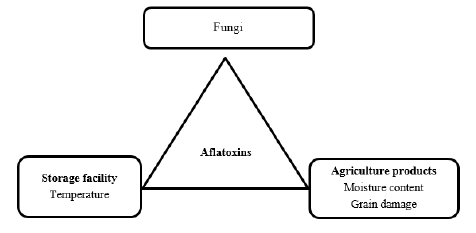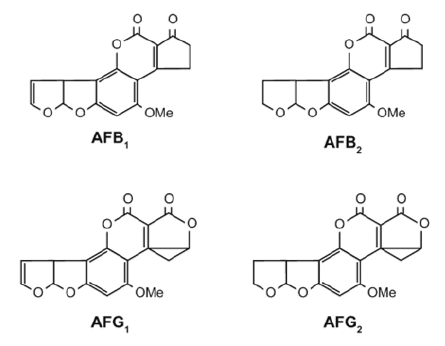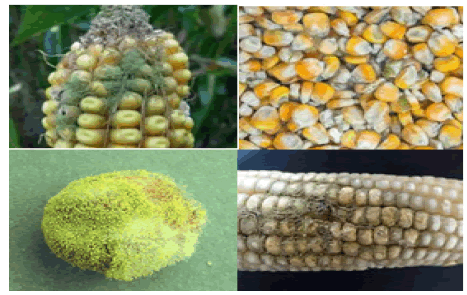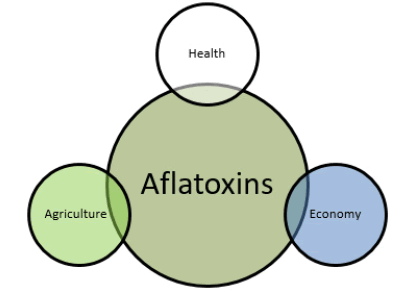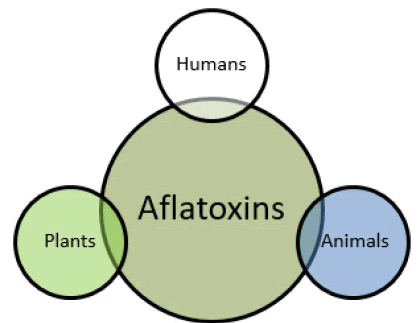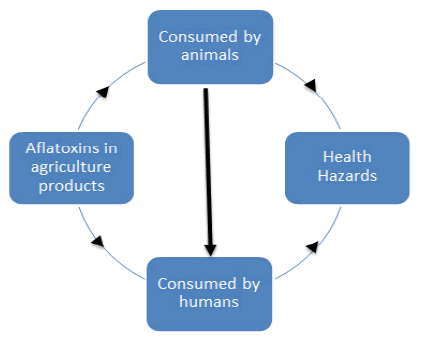Aflatoxins a one health concern
2 Department of Microbiology, Abbottabad University of Science & Technology, Pakistan
Received: 08-Aug-2022, Manuscript No. pulbecr-22-5252; Editor assigned: 11-Aug-2022, Pre QC No. pulbecr-22-5252 (PQ); Accepted Date: Aug 31, 2022; Reviewed: 25-Aug-2022 QC No. pulbecr-22-5252 (Q); Revised: 29-Aug-2022, Manuscript No. pulbecr-22-5252 (R); Published: 05-Sep-2022, DOI: DOI:10.37532/PULBECR .2022.4(4).23-25.
Citation: Byarugaba I, Faizan A. Aflatoxins a one health concern. J Biomed Eng:Curr Res. 2022;4(4):23-25.
This open-access article is distributed under the terms of the Creative Commons Attribution Non-Commercial License (CC BY-NC) (http://creativecommons.org/licenses/by-nc/4.0/), which permits reuse, distribution and reproduction of the article, provided that the original work is properly cited and the reuse is restricted to noncommercial purposes. For commercial reuse, contact reprints@pulsus.com
Abstract
Aflatoxins are toxins biosynthesized by fungi Aspergillus flavus & Aspergillus parasiticus. They are colorless, cannot be detected under normal light, they are odorless and contaminated foods most often do not have any special or bad smell. Environmental factors such as the temperature, vectors causing grain damage have a significant impact on favoring the colonization of fungi and production of aflatoxins. They contaminate agriculture products worldwide affecting their quality, safety & security. The effects on safety & security cause health threats among people and animals on their long term exposure through consumption because they are mutagenic, teratogenic, genotoxic, and carcinogenic. Information associated with the production of aflatoxins in agriculture products in most developing countries like Uganda is still lacking due to lack of public awareness on aflatoxins and their effects on health and economic growth. We are therefore focusing on the increasing public awareness on what aflatoxins are and their effects
Key Words
Aflatoxicosis; Food security and safety; Fungi; One health.
Background
Aflatoxins are toxins biosynthesized by fungi Aspergillus Flavus and Aspergillus Parasiticus which are abundant in nature hence lying in the category of mycotoxins [1]. The name aflatoxins were derived from a combination of Afla and toxins where ‘A’ in afla stand for Aspergillus & ‘fla’ stand for flavus. Chemically, aflatoxins are derivatives of difurano coumarins possessing a bifuran group attached to the coumarin nucleus a pentanone ring [2]. Aflatoxins were first discovered in England during the 1960’s when an estimate of 100,000 turkeys died after they had been fed with feeds contaminated with the fungi Aspergillus flavus. Environmental factors have a significant impact on aflatoxin contamination [3]. An increase in temperature by every 2°C in European nations proved to raise the risk of aflatoxin production in cereals and the probability of contamination of cereals such as maize is likely to keep increasing for the next thirty years due to ideal meteorological circumstances [4, 5]. Fungi colonization on the agricultural products the initial point through which aflatoxins enter the chain is favored by their nature (grain damage), moisture, and the environment temperatures (Figure 1). Fungi grow in areas with a temperature range of 12°C to 48°C producing aflatoxins at a temperature range of 25°C to 37°C and moisture levels of 80% to 85% [6,1]. During this temperature range, agricultural produce are experiencing a high rate of respiration. One of the outcomes being water vapour, will lead to an increase in the moisture content providing the favourable environment for fungi colonization and synthesis of aflatoxins when it increases beyond 14%. The temperature range also favors the expression of genes by the fungi for the production of aflatoxins. In Uganda, where agricultural production is very high, the environmental temperatures
lie between 40°N and 40°S of the equator the range with which growth of fungi and aflatoxin production is favored hence exposing the environment and its components to aflatoxins effects.
TYPES OF AFLATOXINS
Aflatoxins are of different types. More than 20 are known however, only four are major ones aflatoxins B1 (AFB1), B2 (AFB2), G1 (AFG1) & G2 (AFG2) (Figure 2). Aflatoxins B1 & B2 are hydroxylated when consumed by animals to M1 (AFM1) & M2 (AFM2) respectively [7]. AFB1 and AFB2 are found in crops and or their products whereas AFM1 and AFM2 are found in animal by-products. AFB1 & AFB2 are synthesized by the fungi Aspergillus flavus whereas AFG1 & AFG2 are synthesized by the fungi Aspergillus parasiticus.
CHARACTERISTICS OF AFLATOXINS
Aflatoxins are colorless and cannot be detected under normal light and can be made visible under UV light (basic detection method), they are odorless and contaminated food most often does not have any special or bad smell. Sometimes grains can smell moldy due to fungal contamination when the moisture content of the contaminated product is still high. They are insoluble in water, soluble in polar solvents such as methane & chloroform, they are unstable in extreme pH (<3 or>10). Aspergillus flavus fungi are green and can multiply their population under stressful conditions. Penetration and colonization of fungi in crops are also supplemented by the injuries caused by vectors such as insects and nematode [8]. They decompose at temperatures of 237°C to 306°C hence do not decompose quickly [9]. Therefore, preventing the growth of the fungi and or detoxification of contaminated feeds and foods is critical in the control of aflatoxin effects [10].
AFLATOXIN CONTAMINATION PREVALENCE IN AGRICULTURAL PRODUCTS
Contamination of food and feeds with aflatoxins worldwide presents major food and feed safety issues in areas of the world with warm temperatures and high humidity which encourage fungi growth (Figure 3). Fungi colonization and contamination usually happen during the pre-harvesting, harvesting, and post-harvesting sessions leading to the synthesis of aflatoxins. According to FAO, more than 25% of the world’s agricultural commodities are contaminated by aflatoxins resulting in health issues when consumed. Aflatoxin contamination also results in loss of market value [11]. Mycotoxin contamination in Sub-Saharan Africa among agriculture products is a great threat to health where more than 250,000 death occurring annually are hepatocellular carcinoma-related resulting from aflatoxin contamination alone [12]. In Uganda, more than 60% of the population carries out farming in which mycotoxins remain a scourge unprecedentedly reducing the nutritional and economic value of agricultural products [13]. The economic growth of many developing countries like Uganda greatly depends on the trading of agriculture products and due to the poorly equipped preharvesting, during harvesting and post-harvesting handling by farmers and the favoring environmental conditions leads to an increase in aflatoxins contamination hence high levels beyond the acceptable quantities (Figure 4) [14]. According to WHO, in Africa, the aflatoxins burden accounts for about 40% of daily diseases. In 1974, there was an outbreak of Hepatitis in India due to aflatoxins which were found in their staple food maize. In Kenya, there are reported cases of disease outbreaks due to the consumption of maize a staple food that also is a source of animal feeds contaminated with aflatoxins. In 2013, countries in Europe reported contamination of milk with aflatoxin which was acquired by the animals through the feeds.
Figure 4: Aflatoxins affecting agriculture, Economy and health
In 2021, the government of Kenya suspended the importation of maize from Uganda because they were found contaminated with aflatoxins and their levels had accumulated beyond standard measures. In the same year, Uganda missed out on an opportunity of exporting 5 million metric tons of maize to Iranian because of the aflatoxins contamination. All these scenarios impacted her economy negatively
RISK ASSOCIATED WITH AFLATOXINS
Aflatoxins are toxins (poisonous substances) produced within the cells of organisms. They are thus among the most dangerous compounds affecting the physiological processes of plants, animals, and humans (Figure 5). This is referred to as Alatoxicosis hence a one health concern. One health is a collaborative, multisector, and transdisciplinary approach working to achieve optimal health outcomes by recognizing the interconnection between people, animals, plants, and their shared environment. Aflatoxins affect food safety and security one of the issues one health program focuses on rectifying. This causes health threats among people and animals on their long-term exposure through consumption because of their mutagenic, teratogenic, genotoxic, and carcinogenic nature [15, 16]. All vertebrate species are susceptible to Aflatoxicosis with animals being more susceptible at a lower aflatoxin concentration as compared to humans [6]. The occurrence of aflatoxins in feeds and foods of animals results in a decline in productivity (of meat, eggs & milk), reduction in weight gain, and an increase in disease incidences due to their immunosuppression abilities and the damage to vital organs [17].
Figure 5: Aflatoxins a One Health issue affecting plants, humans
On consumption of agriculture products contaminated with aflatoxins by both animals and humans, health issues arise. When animals feeding on agricultural produce are eaten or their products are eaten by humans, these aflatoxins will be expressed in different tissues ending up in human bodies thus being hazardous (Figure 6). Aflatoxins in humans affect the liver, and kidneys, cause spleen enlargement, decrease protein and fats digestion as well as absorption, cause impaired carbohydrate breakdown, cause reduced sperm count and infertility, birth defects, higher incidence of cancer, decreased resistance and increased susceptibility to infections.
CHEMICAL AND BIOLOGICAL EFFECTS OF AFLATOXINS
Aside from work related to structure elucidation, little systematic research has been carried out to find out the behavior & reactivity of aflatoxins, and agricultural products when treated with chemicals. When the catalytic hydrogenation of aflatoxin B1 is completed, it results in the uptake of 3 moles of hydrogen forming a tetra hydro deoxy derivative. When the hydrogenation process is interrupted after 1mole of hydrogen is taken up, aflatoxin B2 is produced in a quantifiable quantity [18]. Aflatoxins can contaminate various agricultural products such as maize, g. nuts, barley, wheat, rice, sorghum, millet, soybeans, cassava, oilseeds, fruits, eggs, meat, animal feeds, and milk [19, 20].
Aflatoxins enter the food and feed chain at any time point from preharvest to consumption causing a lot of reactions within the cells [21, 22]. When the fungi colonize the plants in presence of favorable conditions, aflatoxins are produced which compromise the self-defense and growth of the plants and contaminate the crop seeds affecting the quality of the yield.Once produced within cells, aflatoxins cause programmed cell death (apoptosis), and inhibit nucleic acid synthesis leading to a decrease in protein synthesis hence stunting growth; mutations affect the cell membrane stability leading to cell damage.
Conclusion
Information on the contamination and colonization of fungi and the negative impacts associated with it through the production of aflatoxins in agriculture products in Uganda and most other developing countries is still lacking due to a lack of public awareness on their effects on the quality of agriculture products and their potentially hazardous effects on human and animals health. We are therefore focusing on increasing public awareness about aflatoxins and their effects on agriculture, health, and economic growth. Through this study, information on what aflatoxins are, how they come about, and what harm they are capable of creating has been developed which will be used to make informed decisions and increase general awareness and personal protection. The outcomes of the study will be used for further developments such as the development of biological control measures for the fungi and aflatoxins as well as improved implementation of the presently available preventative measures.
References
- Pitt JI, Hocking AD. Fungi and food spoilage. Springer. 2009;519.
- Klich MA, Tang S, Denning DW. Aflatoxin and ochratoxin production by Aspergillus species under ex vivo conditions. Mycopathologia.2009;168(4):185-91.
[Google Scholar] [Cross Ref]
- Guchi E. Implication of aflatoxin contamination in agricultural products. Am J Food Nutr.2015;3(1):12-20.
- Battilani P, Toscano P, Der FelsKlerx V, et al. Aflatoxin B1 contamination in maize in Europe increases due to climate change. Scientific Reports. 2016;6(1):1-7.
[Google Scholar] [Cross Ref]
- Moretti A, Pascale M, Logrieco AF. Mycotoxin risks under a climate change scenario in Europe. Trends food sci technol.2019;84:38-40.
- Coppock RW, Christian RG, Jacobsen BJ. Aflatoxins. In Vet Toxicol Academic Press. 2018;983-94.
- Inan F, Pala M, Doymaz I. Use of ozone in detoxification of aflatoxin B1 in red pepper. J Stored Prod Res. 2007;43(4):425-29.
- Kumar A, Pathak H, Bhadauria S, et al. Aflatoxin contamination in food crops: Causes, detection and management: A review. Food Prod Process Nutr. 2021;3(1):1-9.
[Google Scholar] [Cross Ref]
- Rustom IY. Aflatoxin in food and feed: Occurrence, legislation and inactivation by physical methods. Food Chem. 1997;59(1): 57-67.
- Jasutiene I, Garmiene G, Kulikauskiene M. Pasteurization and fermentation effects on Aflatoxin M1 stability. Milchwissenschaft, 2006;61(1):75-9.
[Google Scholar] [Cross Ref]
- Jalili M. A review on aflatoxins reduction in food. Iran J Health Saf Environ.2016;3(1):445-59.
[Google Scholar] [Cross Ref]
- Echodu R, Malinga GM, Kaducu J, et al. Prevalence of aflatoxins, ochratoxin and deoxynivalenol in cereal grains in Northern Uganda: Implication for food safety and health. 2019;6:1012-17
- Omara T, Nassazi W, Omute T, et al. Aflatoxins in Uganda: An encyclopedic review of the etiology, epidemiology, detection, quantification, exposure assessment, reduction and control. Int J microbiol.2020.
- Smith JE. Aflatoxins. In Handbook of plant and fungal toxicants. 2020;269-85.
- Peles F, Sipos P, Gyori Z, et al. Adverse effects, transformation and channeling of aflatoxins into food raw materials in livestock. Front Microbiol. 2019;10:2861.
- Raduly Z, Szabo L, Madar A, et al. Toxicological and medical aspects of Aspergillus-derived mycotoxins entering the feed and food chain. Front Microbiol. 2020;10:2908.
- Robens JF, Richard JL. Aflatoxins in animal and human health. Rev Environ Contam Toxicol. 1992;127:69-94.
[Google Scholar] [Cross Ref]
- Wogan GN. Chemical nature and biological effects of aflatoxins. Bacteriol Rev.1966;30(2):460-70.
[Google Scholar] [Cross Ref]
- Lizarraga-Paulin E, Miranda-Castro S, Moreno-Martinez E, et al. Novel methods for preventing and controlling aflatoxins in food: A worldwide daily challenge. Aflatoxins-Recent Adv Future Prospects. 2013;93-128.
[Google Scholar] [Cross Ref]
- Tola M, Kebede B. Occurrence, importance and control of mycotoxins: A review. Cogent Food Agric. 2016;2(1):1191103.
- Norlia M, Jinap S, Nor-Khaizura M, et al. Aspergillus section flavi and aflatoxin: Occurrence, detection and identification in raw peanuts and peanut-based products along the supply chain. Front Microbiol. 2019;10:2602.
- Torres AM, Barros GG, Palacios SA, et al. Review on pre-and post-harvest management of peanuts to minimize aflatoxin contamination. Food Res Int. 2014;62:11-9.




